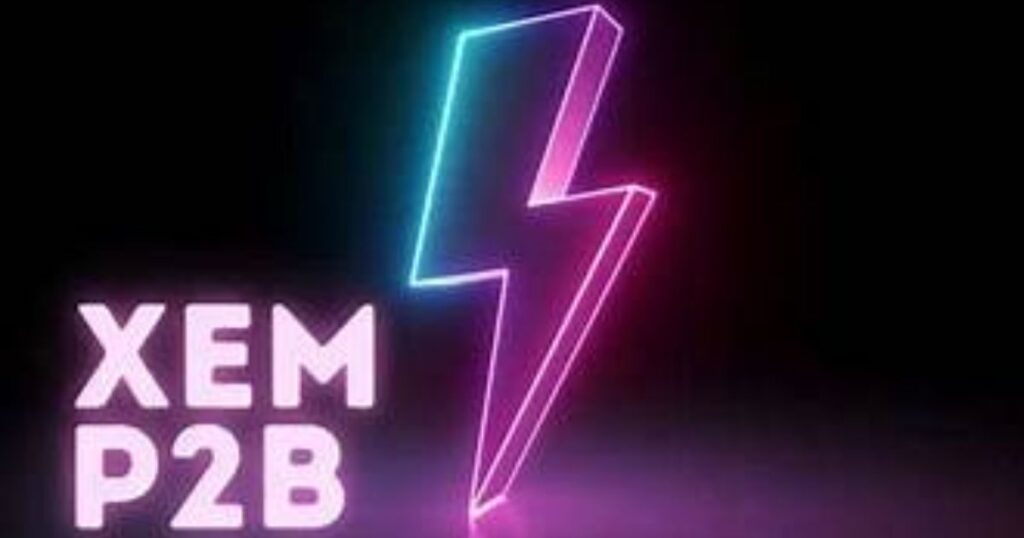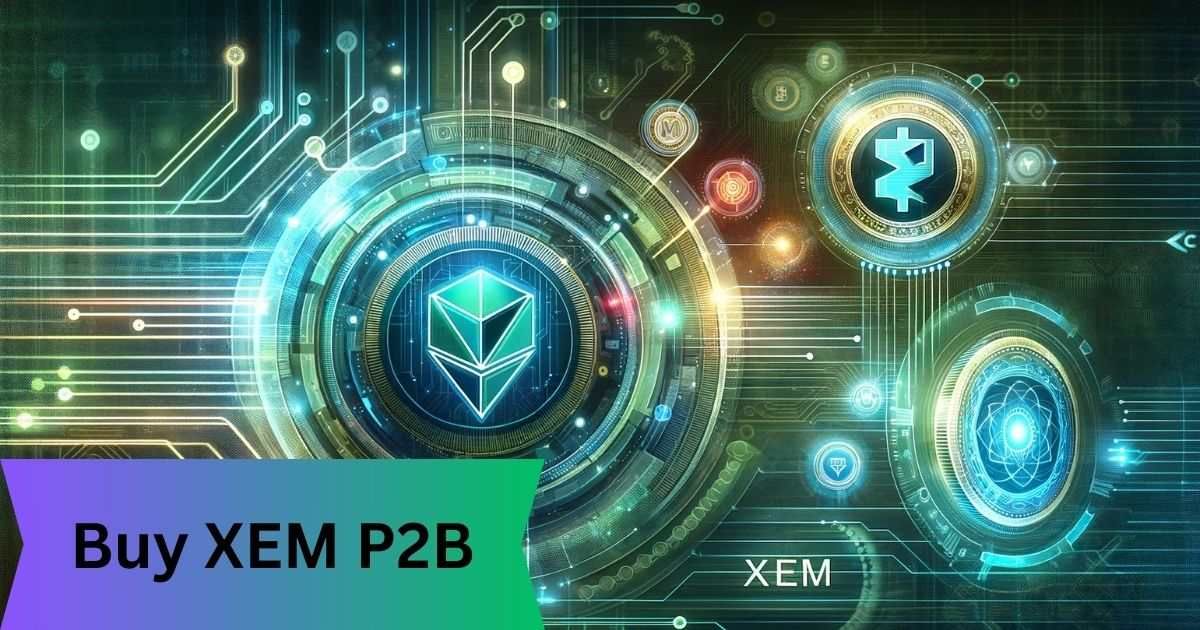Are you ready to move into the world of cryptocurrency and explore a game-changing digital asset? Look no further than XEM, the native token of the New Economy Movement (NEM). In this comprehensive guide, we’ll walk you through everything you need to know about XEM and how to buy XEM P2B.
Whether you’re a seasoned crypto enthusiast or just dipping your toes into the digital currency pool, you’ll find valuable insights and practical tips to help you navigate this exciting investment opportunity.
What is NEM (XEM)?
NEM, short for New Economy Movement, isn’t just another cryptocurrency – it’s a revolution in the making. Launched in 2015, NEM is a blockchain platform that’s been turning heads in the crypto world. At its core, XEM is the native cryptocurrency that powers this innovative decentralized ecosystem.
Think of NEM as the Swiss Army knife of blockchain technology. It’s not just about sending and receiving money; it’s a whole toolkit for building decentralized applications and managing digital assets. What sets NEM apart is its unique Proof of Importance (POI) algorithm, which rewards users based on their overall contribution to the network, not just how much XEM they hold.
About NEM: A Deep Dive
Let’s peel back the layers and really get to know NEM. This blockchain network isn’t just another Bitcoin wannabe it’s carving out its own niche in the crypto ecosystem. NEM was built from the ground up with businesses in mind, offering a platform that’s both powerful and easy to use.
The vision behind NEM is simple yet ambitious: create a blockchain environment that’s accessible to everyone, from big corporations to small startups. It’s all about leveling the playing field and opening up new possibilities in the world of digital assets.
What makes NEM stand out in the crowded crypto landscape? For starters, its modular smart asset system is like Lego for blockchain – you can build pretty much anything you want on it. Plus, its focus on scalability and speed means it can handle a high volume of transactions without breaking a sweat.
Major Features of NEM (XEM)

Now, let’s talk about the cool stuff that makes NEM tick:
- Proof of Importance (POI) Algorithm: Forget about energy-hungry mining rigs. NEM’s POI system rewards users based on how much they contribute to the network. It’s like a blockchain popularity contest, but with actual benefits.
- Harvesting: This is NEM’s twist on mining. Instead of solving complex math problems, users “harvest” blocks by essentially lending their account balance to the network. It’s a more eco-friendly way to earn rewards.
- Multi-signature Accounts: Need multiple people to sign off on transactions? NEM’s got you covered with multi-sig accounts. It’s perfect for businesses or groups managing shared funds.
- Namespaces and Mosaics: Think of these as domain names and assets on the NEM blockchain. You can create your own unique identifiers and even issue your own tokens.
- Smart Asset System: This is where NEM really shines for businesses. It allows for easy creation and management of digital assets, from cryptocurrencies to loyalty points.
The Evolution of NEM: From Inception to Present
NEM’s journey is like a classic rags-to-riches story, but with more code and less drama. Born from the ashes of an earlier project, NEM was launched in 2015 with a vision to create a more inclusive and efficient blockchain.
Key milestones in NEM’s evolution:
- 2014: Development begins
- 2015: NEM mainnet launches
- 2016: Catapult (now known as Symbol) development starts
- 2018: NEM Foundation restructures
- 2021: Symbol blockchain launches, expanding NEM’s capabilities
Today, NEM stands as a mature platform with a growing ecosystem of apps and services. It’s being used for everything from supply chain management to voting systems, proving its versatility in the real world.
How Does NEM (XEM) Work?
At its heart, NEM is a distributed ledger that records transactions and data in a secure, transparent way. But it’s the way NEM handles these transactions that sets it apart.
The NEM blockchain uses a unique harvesting system to create new blocks. When you initiate a transaction, it gets bundled with others into a block. Harvesters then compete to process this block, with the winner getting rewarded in XEM.
But here’s the cool part: NEM’s Smart Asset System allows you to do way more than just send XEM back and forth. You can create and manage complex digital assets, set up automated business logic, and even build entire applications on the NEM blockchain.
How to Buy XEM P2B: A Comprehensive Guide
Ready to get your hands on some XEM? Here’s your step-by-step guide to buy XEM P2B:
- Choose a cryptocurrency exchange that supports XEM. P2B is a popular choice, known for its user-friendly interface and robust security measures.
- Create an account on P2B. You’ll need to provide some basic information and verify your identity.
- Fund your account. You can usually do this with a bank transfer, credit card, or by depositing other cryptocurrencies.
- Navigate to the XEM/USDT trading pair (or whichever pair you prefer).
- Place your order. You can choose a market order to buy at the current price, or a limit order to set your own price.
- Once your order is filled, congratulations! You now own XEM.
Remember, always do your own research and never invest more than you can afford to lose. Cryptocurrency investments can be volatile, so proceed with caution.
Read More : Trade 12.0 Urex : A Deep Dive into the Future of Trading
Other Systems and Features Used by NEM
NEM isn’t just about its main blockchain. It’s got a whole ecosystem of tools and features:
- Catapult (Symbol): This is NEM’s next-generation blockchain, offering even more speed and flexibility.
- Apostille: A notarization system built on NEM, perfect for verifying documents.
- Mijin: A private blockchain solution for enterprises, powered by NEM technology.
These features make NEM a versatile platform for all sorts of applications, from supply chain management to digital identity solutions.
NEM (XEM) Pros and Cons
Like any technology, NEM has its strengths and weaknesses. Let’s break them down:
Pros:
- Fast transaction times
- Low fees
- Versatile Smart Asset System
- Eco-friendly consensus mechanism
Cons:
- Less widely adopted than some other cryptocurrencies
- Limited smart contract functionality compared to platforms like Ethereum
- Price volatility (common to most cryptocurrencies)
Risks and Challenges of Investing in XEM P2B
Like any investment, investing in xem p2b comes with risks. One of the major concerns is market volatility, which can affect the value of your digital assets. It is essential to understand the risks before making an investment decision, as fluctuations in the market can lead to price instability. However, the decentralized ledger of NEM ensures a level of stability that helps in financial hedging.
Another challenge is ensuring regulatory compliance. Different countries have different rules governing cryptocurrencies, and it is important to understand these rules to stay within the law. For example, compliance standards might require you to report your earnings from staking or crypto transactions.
Prospects of NEM (XEM)
The future looks bright for NEM. With its focus on business applications and scalability, it’s well-positioned to capture a significant share of the enterprise blockchain market.
Upcoming developments like further integration with the Symbol blockchain and new partnerships in various industries could drive adoption and potentially increase XEM’s value.
As with any investment, there are no guarantees. The cryptocurrency market is notoriously unpredictable, so always approach with caution and do your due diligence.
Is NEM (XEM) Mining Possible?
Here’s a fun fact: you don’t actually “mine” XEM in the traditional sense. Instead, NEM uses a process called harvesting. It’s like mining’s eco-friendly cousin.
To participate in harvesting, you need to have at least 10,000 XEM in your account. Once you do, you can start harvesting blocks and earning rewards. It’s a great way to earn passive income from your XEM holdings.
Is XEM Worth Investing In?

Now for the million-dollar question (or should we say million-XEM question?): is XEM a good investment?
The truth is, like any cryptocurrency, XEM comes with its share of risks and potential rewards. On the plus side, NEM’s technology is solid, with real-world applications that go beyond simple value transfer.
Its focus on business solutions could lead to increased adoption and value in the long run. On the flip side, the crypto market is volatile, and XEM isn’t immune to price swings. Plus, it faces stiff competition from other blockchain platforms.
Ultimately, whether XEM is worth investing in depends on your personal financial goals, risk tolerance, and belief in the project’s long-term potential. As always, never invest more than you can afford to lose, and consider consulting with a financial advisor before making any major investment decisions.
Unlocking Opportunities: Why You Should Consider Buying XEM P2B
So, why should you consider jumping on the XEM bandwagon? Here are a few compelling reasons:
- Innovative Technology: NEM’s unique features like POI and the Smart Asset System set it apart from other cryptocurrencies.
- Business Focus: NEM is designed with businesses in mind, which could lead to increased adoption and value.
- Passive Income: Through harvesting, you can earn rewards just by holding XEM.
- Potential Growth: As blockchain technology becomes more mainstream, platforms like NEM could see significant growth.
- Diversification: Adding XEM to your portfolio can help diversify your cryptocurrency investments.
Control Finances and Gain Returns with Strategies to Buy XEM P2B
Ready to take the plunge? Here are some strategies to consider when buying XEM P2B:
- Dollar-Cost Averaging: Instead of buying all at once, consider spreading your purchases over time to average out price fluctuations.
- Set Clear Goals: Decide whether you’re in it for the short term or long haul, and set your buying strategy accordingly.
- Stay Informed: Keep up with NEM news and developments. The more you know, the better decisions you can make.
- Use Limit Orders: When buying on P2B, consider using limit orders to get the best price possible.
- Secure Your XEM: After buying, consider moving your XEM to a secure wallet for safekeeping.
Conclusion
As we wrap up our deep dive into NEM and how to buy XEM P2B, remember that the world of cryptocurrency is as exciting as it is unpredictable. NEM offers a unique blend of innovative technology, business focus, and potential for growth that makes it an intriguing option for investors and blockchain enthusiasts alike.
Whether you’re looking to diversify your crypto portfolio, explore new blockchain technologies, or potentially earn passive income through harvesting, XEM could be worth considering. Just remember to approach any investment with caution, do your own research, and never invest more than you can afford to lose.
FAQs
What makes NEM different from other cryptocurrencies?
NEM stands out with its Proof of Importance algorithm, harvesting system, and focus on business applications. Its Smart Asset System also allows for easy creation and management of digital assets.
How secure is the NEM blockchain?
NEM uses advanced cryptography and its unique consensus mechanism to ensure high security. However, as with any digital system, it’s important to follow best practices for safeguarding your assets.
Can I use XEM for everyday transactions?
While it’s possible, XEM is currently more commonly used for business applications and as an investment. However, as adoption grows, we may see more everyday use cases emerge.
What’s the difference between NEM and Symbol?
Symbol is the next-generation blockchain built by the NEM team. It offers enhanced features and performance while maintaining compatibility with the original NEM blockchain.
How do I store my XEM safely after buying on P2B?
After buying XEM on P2B, you can store it in the exchange wallet. For long-term storage, it’s recommended to transfer your XEM to a personal wallet, either a software wallet on your computer or smartphone, or a hardware wallet for maximum security.

With three years of experience in website development, I share the latest in technology on my blog, [TechTimy]. Join me for insights, trends, and updates in the tech world.



